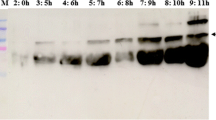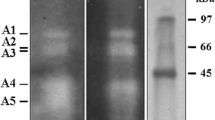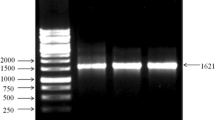Abstract
Vegetative insecticidal proteins produced by some Bacillus thuringiensis strains are specifically toxic to different agricultural pests such as the polyphagous Spodoptera and several other Lepidopteran insects, but one of the major problems found in the use of these biopesticides was the lack of an easy and credible method of quantification of such secreted toxins. Heterologous expression of B. thuringiensis Vip3Aa16 toxin was performed in Escherichia coli then the protein was purified by chromatography. Using blood agar as well as blood agar overlay (zymogram assay), we reported, for the first time, the capacity of Vip3Aa16 to induce hemolysis. The hemolytic activity of this protein was shown to be relatively stable after treatment at 40 °C and at a range of pH between 6.5 and 9. Moreover, a linear relationship was shown between hemolysis levels and Vip3Aa16 concentrations. The model established in the present study could quantify Vip3A toxin as a function of hemolytic activity and the assay proposed showed to be a simple and low-cost method to readily assess Vip3A toxins in liquid cultures and facilitate the use of this kind of bioinsecticides in pest management programs.



Similar content being viewed by others
References
Abdelkefi-Mesrati L, Boukedi H, Chakroun M, Kamoun F, Azzouz H, Tounsi S, Rouis S, Jaoua S (2011) Investigation of the steps involved in the difference of susceptibility of Ephestia kuehniella and Spodoptera littoralis to the Bacillus thuringiensis Vip3Aa16 toxin. J Invertebr Pathol 107:198–201
Abdelkefi-Mesrati L, Boukedi H, Dammak-Karray M, Sellami-Boudawara T, Jaoua S, Tounsi S (2011) Study of the Bacillus thuringiensis Vip3Aa16 histopathological effects and determination of its putative binding proteins in the midgut of Spodoptera littoralis. J Invertebr Pathol 106:250–254
Abdelkefi-Mesrati L, Rouis S, Sellami S, Jaoua S (2009) Prays oleae midgut putative receptor of Bacillus thuringiensis vegetative insecticidal protein Vip3LB differs from that of Cry1Ac toxin. Mol Biotechnol 43:15–19
Ben Hamadou-Charfi D, Boukedi H, Abdelkefi-Mesrati L, Tounsi S, Jaoua S (2013) Agrotis segetum midgut putative receptor of Bacillus thuringiensis vegetative insecticidal protein Vip3Aa16 differs from that of Cry1Ac toxin. J Invertebr Pathol 114:139–143
Boukedi H, Ben Khedher S, Triki N, Kamoun F, Saadaoui I, Chakroun M, Tounsi S, Abdelkefi-Mesrati L (2015) Overproduction of the Bacillus thuringiensis Vip3Aa16 toxin and study of its insecticidal activity against the carob moth Ectomyelois ceratoniae. J Invertebr Pathol 127:127–129
Boukedi H, Tounsi S, Abdelkefi-Mesrati L (2016) Abiotic factors affecting the larvicidal activity of the Bacillus thuringiensis Vip3Aa16 toxin against the lepidopteran pest Ephestia kuehniella. J Plant Dis Prot 123:59–64
Bradford MM (1976) A rapid and sensitive method for the quantification of microgram quantities of protein utilising the principle of protein-dye binding. Anal Biochem 72: 248–254.
Butko P (2003) Cytolytic toxin Cyt1A and its mechanism of membrane damage: data and hypotheses. Appl Environ Microbiol 69:2415–2422
Chu L, Bramanti TE, Ebersole JL, Holt SC (1991) Hemolytic activity in the periodontopathogen Porphyromonas gingivalis: kinetics of enzyme release and localization. Infect Immun 56:1932–1940
Estruch JJ, Warren GW, Mullins MA, Nye GJ, Craig JA, Koziel MG (1996) Vip3A, a novel Bacillus thuringiensis vegetative insecticidal protein with a wide spectrum of activities against lepidopteran insects. Proc Natl Acad Sci USA 93:5389–5394
Fang J, Xu X, Wang P, Zhao JZ, Shelton AM, Cheng J, Feng MG, Shen Z (2007) Characterization of chimeric Bacillus thuringiensis Vip3 toxins. Appl Environ Microbiol 73:956–961
García-Sáez AJ, Buschhorn SB, Keller H, Anderluh G, Simons K, Schwille PJ (2011) Oligomerization and pore formation by equinatoxin II inhibit endocytosis and lead to plasma membrane reorganization. Biol Chem 286:37768–37777
Gardos G (1958) The function of calcium in the potassium permeability of human erythrocytes. Biochem Biophys Acta 30:653–654
Ghribi D, Abdelkefi-Mesrati L, Mnif I, Kammoun R, Ayadi I, Saadaoui I, Maktouf S, Chaabouni-Ellouze S (2012) Investigation of antimicrobial activity and statistical optimization of Bacillus subtilis SPB1 biosurfactant production in solid-state fermentation. J Biomed Biotechnol. doi:10.1155/2012/373682
Hernández-Rodríguez CS, Boets A, Van Rie J, Ferré J (2009) Screening and identification of vip genes in Bacillus thuringiensis strains. Appl Microbiol 107:219–225
Höfte H, Whiteley HR (1989) Insecticidal crystal proteins of Bacillus thuringiensis. Microbiol Rev 53:242–255
Kenny DA (1979) Correlation and causality. Wiley, New York
Liu J, Song F, Zhang J, Liu R, He K, Tan J, Huang D (2007) Identification of vip3Atype genes from Bacillus thuringiensis strains and characterization of a novel vip3A-type gene. Lett Appl Microbiol 45:432–438
Macián M, Seguer J, Infante MR, Selve C, Vinardell MP (1996) Preliminary studies of the toxic effects of non-ionic surfactants derived from lysine. Toxicology 106:1–9
Naimov S, Boncheva R, Karlova R, Dukiandjiev S, Minkov I, de Maagd RA (2008) Solubilization, activation, and insecticidal activity of Bacillus thuringiensis serovar thompsoni HD542 crystal proteins. Appl Environ Microbiol 74:7145–7151
Promdonkoy B, Ellar DJ (2003) Investigation of the pore-forming mechanism of a cytolytic δ-endotoxin from Bacillus thuringiensis. Biochem J 374:255–259
Promdonkoy B, Rungrod A, Promdonkoy P, Pathaichindachote W, Krittanai C, Panyim SJ (2008) Amino acid substitutions in αA and αC of Cyt2Aa2 alter hemolytic activity and mosquito-larvicidal specificity. J Biotechnol 133:287–293.
Purcell JP, Greenplate JT, Sammons RD (1992) Examination of midgut luminal proteinase activities in six economically important insects. Insect Biochem Mol Biol 22:41–47
Romero PJ, Romero EA (1999) The role of calcium metabolism in human red blood cell ageing: a proposal. Blood Cells Mol Dis 25:9–19
Sabirov RZ, Krasilnikov OV, Ternovsky VI, Merzliak PG (1993) Relation between ionic channel conductance and conductivity of media containing different nonelectrolytes. A novel method of pore size determination. Gen Physiol Biophys 12:95–111
Savva CG, Fernandes da Costa SP, Bokori-Brown M, Naylor CE, Cole AR, Moss DS, Titball RW, Basak AK (2013) Molecular architecture and functional analysis of NetB, a pore-forming toxin from Clostridium perfringens. J Biol Chem 288:3512–3522
Szabo E, Murvai J, Fabian P, Fabian F, Hollosi M, Kajtar J, Buzas Z, Sajgo M, Pongor S, Asboth B (1993) Is an amphiphilic region responsible for the haemolytic activity of Bacillus thuringiensis toxin? Int J Pept Protein Res 42:527–532
Thompson M, Ellison SL, Wood R (2002) Harmonized guidelines for single laboratory validation of methods of analysis. Pure Appl Chem 74:835–855
Weinstein SA, Bernheimer AW, Oppenheim JD (1988) Kinetics of hemolysis induced by a toxin from Bacillus thuringiensis israelensis. Toxicon 26:1177–1185
Yu X, Zheng A, Zhu J, Wang S, Wang L, Deng Q, Li S, Liu H, Li P (2010) Characterization of vegetative insecticidal protein vip genes of Bacillus thuringiensis from Sichuan Basin in China. Curr Microbiol 62:752–757
Acknowledgements
This work was supported by the grants from the “Ministry of Higher Education and Scientific Research, Tunisia”.
Author information
Authors and Affiliations
Corresponding author
Ethics declarations
Conflict of interest
No conflict of interest declared.
Rights and permissions
About this article
Cite this article
Boukedi, H., Ben Khedher, S., Ghribi, D. et al. Quantification of Bacillus thuringiensis Vip3Aa16 Entomopathogenic Toxin Using Its Hemolytic Activity. Curr Microbiol 74, 584–588 (2017). https://doi.org/10.1007/s00284-017-1224-z
Received:
Accepted:
Published:
Issue Date:
DOI: https://doi.org/10.1007/s00284-017-1224-z




